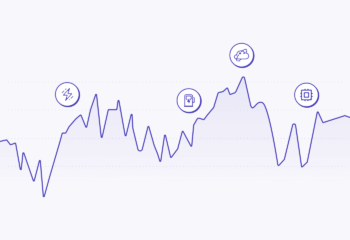This post is brought to you by Vested Interest, our forthcoming newsletter about what the financial and economic news might mean for your money, career, and life in general. Please get in touch via askwealthfront@wealthfront.com with comments and questions about other topics you’d like us to cover.
The last two-plus weeks in the stock market have been a roller coaster — and look, we were as reluctant to use that metaphor as you’d imagine, but what else are you going to call something that goes way down and then way up? Over a period of a week earlier this month, the NASDAQ fell 6%, its biggest drop since April’s “Liberation Day”; other major indexes were down big too. Then they spent most of last week climbing in the other direction amid headlines about rallying, rebounding, roaring back and setting record highs — before falling again on Thursday.
What’s going on? Well, unlike with Liberation Day, there isn’t one single story driving the action. Rather, there are a bunch of reasons to be pessimistic and a bunch of reasons to be optimistic right now, and they’re colliding to create volatility in the market. Basically, the economy is fighting with itself about whether the economy is good or not. Let’s review the major data points and arguments involved.
1. Yes, AI is number one. The biggest question of all is whether AI is a bubble, or to be more specific, whether the so-called Magnificent 7 technology stocks are overvalued. Compare the stock prices of companies in the S&P 500 to their recent earnings — that’s P/E ratio — and you’ll find that prices are even higher, relative to profits, than they were before the original 2000s internet crash.
That could be a sign of overhype. On the other hand, a lot of people believe LLMs and chatbots and AI start-ups will be world-changing, and that chipmakers like Nvidia and cloud-computing titans like Microsoft will earn enough from them to justify their prices. But if you could point to any one reason for the recent stock slide, it would probably be Meta’s Oct. 30 announcement that it’s going to be spending even more on AI infrastructure than expected despite maybe not having a clear plan for monetizing AI.
2. Debt (in unusual forms). Adding to the concern is that high-flying tech companies have been borrowing lots of money to fund AI investments — and doing so in, let’s say, creative ways that have reminded some observers of the arrangements that contributed to the Great Financial Crisis in 2007 and 2008. (Bloomberg, for its part, mentioned the even earlier bankruptcy of Enron in its writeup of one such deal.) Add that to some high-profile debt defaults in other industries and it’s another reason for unease.
3. Troubling numbers (and missing numbers). While the government shutdown was ongoing, investors and their friends at the Federal Reserve didn’t have access to official employment or inflation data. And the privately gathered numbers that did come in were inauspicious: The University of Michigan’s consumer confidence survey found the population at its most pessimistic in years, while one measure of layoff announcements clocked a record number of monthly reductions.
4. A better national and international outlook. There was supposed to be some positive stuff in here, right? Indeed, there is: For one, the government is open again, which means millions of people are going to be getting (and spending) paychecks and benefits that were on hold. Legal experts also suspect the Liberation Day tariffs are going to be struck down by the Supreme Court, and if there’s one thing we learned this spring, it’s that Mr. Market would likely celebrate such a ruling. The current consensus, albeit a tenuous one, is that the Fed will cut interest rates again in December, which could be expected to boost spending. And despite post-Liberation Day fears that the rest of the world was going to stop buying Treasury bonds and conducting transactions in dollars, that just hasn’t happened.
5. Money is still flowing. For all the U.S. consumer’s self-reported anxiety, actual consumer spending continues apace. A hearty 82% of public companies reporting their Q3 revenues “surprised on the upside,” i.e. made more than they’d expected, according to FactSet data. And the National Federation of Retailers is forecasting that consumers will spend more than $1 trillion for the first time during the holiday gift-giving season.
So what does it mean for you? At Wealthfront, we don’t endorse any particular view about where the U.S. economy is headed, nor encourage buying or selling on the basis of such predictions. Our point is merely that there are indicators you could use to make just about any case you want at the moment — and an evident lack of consensus about which ones are most important.
If anything, the past few weeks are a reminder that while the current bull market has lasted for quite a while, stock performance is always liable to reverse quickly. That’s what diversification across companies and asset classes is meant to help lessen the impact of, and why those nearing retirement or planning a major purchase often shift money into more stable holdings like bonds. Volatility is, in some ways, the most predictable part of investing there is.
Disclosure
The information contained in this communication is provided for general informational purposes only, and should not be construed as investment or tax advice. Nothing in this communication should be construed as a solicitation or offer, or recommendation, to buy or sell any security. Any links provided to other server sites are offered as a matter of convenience and are not intended to imply that Wealthfront Advisers or its affiliates endorses, sponsors, promotes and/or is affiliated with the owners of or participants in those sites, or endorses any information contained on those sites, unless expressly stated otherwise.
There is no guarantee that a diversified portfolio will enhance overall returns or outperform a non-diversified portfolio. Diversification does not protect against market risk.
Investment management and advisory services are provided by Wealthfront Advisers LLC (“Wealthfront Advisers”), an SEC-registered investment adviser.
Wealthfront Advisers is a wholly-owned subsidiary of Wealthfront Corporation.
© 2025 Wealthfront Corporation. All rights reserved.
About the author(s)
Vested Interest covers the financial and economic news and what it might mean for your money, career, and life in general. View all posts by The Vested Interest editors



